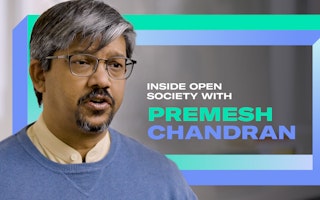Desert of Forbidden Art
By Andrea Csanadi & Eleanor Kelly

In a remote desert in north western Uzbekistan, a small, unpretentious museum houses one of the world’s most remarkable collections of 20th century Russian art. Worth many millions of dollars, the collection is a treasure trove of once banned Soviet art and testament to a small group of artists and art lovers, who risked torture, imprisonment and death to create and protect these unique avant-garde works. A new Emmy nominated documentary, The Desert of Forbidden Art, seeks to unravel this story.
Igor Savitsky (1915-84), a Russian born in Kiev, founded the Nukus Museum of Art or, in full, The State Art Museum of the Republic of Karakalpakstan (an autonomous area within Uzbekistan), which opened in 1966. Savitsky began the collection with local Karakalpak artifacts and other Central Asian art. At the same time, the Russian avant-garde movement had begun, including Kliment Red'ko, Lyubov Popova, Mukhina, Ivan Koudriachov and Robert Falk. Though recognized in Western Europe, the Russian avant-garde movement and its work—a direct challenge to state endorsed “Socialist Realism” art—had been banned in the Soviet Union during Joseph Stalin’s rule and through the 1960s.
The plight of this forbidden art and its creators, inspired Savitsky, an artist himself, to take action. Risking denunciation as an “enemy of the people”, Savitsky sought out and assembled over 40,000 Russian avant-garde and post avant-garde pieces of art and housed them in the Nukus Museum.
The story of this forbidden art is, as the Nukus Museum points out, full of paradoxes.
In the Nukus Museum, Russian avant-garde art, denounced by the Soviet State, hangs alongside Socialist Realism works, glorified by the Soviet State. Savitsky sought to preserve a true representation of contemporary art, independent of political agenda. The avant-garde collection, though banned by the Soviet State, was also unwittingly partly financed by it, thanks to Savitsky’s inventive lobbying and good relationship with the Karakalpak authorities. Finally, there is Karakalpak itself; a desolate far off corner, in a far off country, which for more than half a century has served as proud and careful keeper of this eclectic collection.
The story of Igor Savitsky and the Nukus Museum is about much more than Russian art. The determination by a dedicated few to preserve arts and culture from deliberate or accidental destruction during times of political upheaval continues. In the summer of 2003, Afghanistan announced the discovery of several museum boxes in the presidential bank vault in Kabul. Inside these boxes were priceless artifacts rescued after being hidden 14 years earlier by National Museum workers during the chaos of civil war. Workers involved in the transfer swore secrecy and designated "key holders" for the vaults. They kept their covenant through civil war and Taliban rule at enormous personal risk and thanks to these efforts, like those of Savitsky, these “hidden treasures” survive and are back out in the open today.
Arts and culture are often the sources of inspiration that can sustain us in the darkest of circumstances. Too often we assume a government or international NGO will protect our cultural treasures—and sometimes they do—but we as individuals must let these organizations know how deeply we care about our heritage.
Even today, the future of the Nukus museum and the Savitsky collection depends on continued international support, and not just financially. The documentary The Desert of Forbidden Art is one way of achieving this, for the Nukus museum and those other “forbidden” arts that remain in danger of destruction.
The Desert of Forbidden Art is nominated for “Outstanding Arts and Culture Programming” and “For Outstanding Individual Achievement in Music”. A trailer for the documentary can be viewed here.
Andrea Csanadi is formerly the director of the Open Society Arts and Culture Program.
Until May 2021, Eleanor Kelly was the regional head of communications for the Open Society Foundations.


